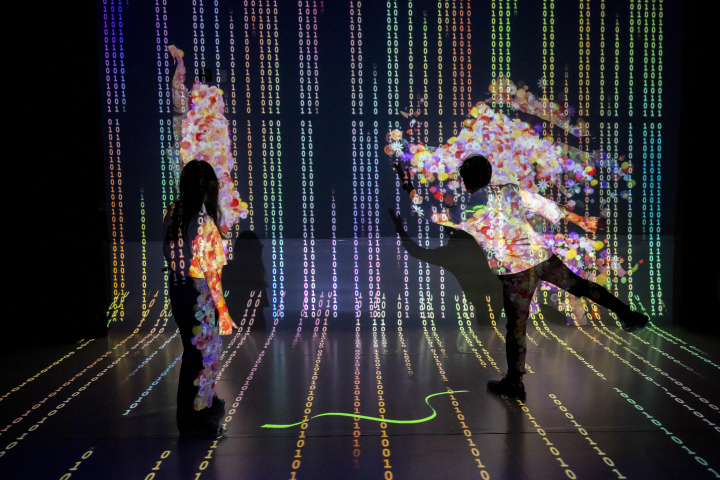UMD's Immersive Media Design Program Bridges Art and Technology
The rapid integration of technology into everyday life has brought new possibilities for creative expression and innovation. One area seeing significant advancement is immersive media, which engages viewers with sight, sound and other sensory experiences, encouraging interaction with digital environments. The University of Maryland’s Department of Computer Science offers a program dedicated to this field: Immersive Media Design (IMD).
Founded to meet the the growing demand for interdisciplinary expertise, the IMD program provides undergraduates with the tools to explore emerging technologies like virtual, augmented and extended reality. Students can pursue either a Bachelor of Arts in Emerging Creatives or a Bachelor of Science in Computing. Both tracks are designed to foster collaboration across disciplines and prepare students for careers at the intersection of art and technology. With more than 130 students, 20 staff and faculty and newly hired Assistant Director Georgia Creson, the program is ready to expand its significance.
In a Q&A, Professor of Computer Science Roger Eastman, director of the IMD program, shares insights on its evolution, goals and impact.
Q: What inspired the creation of the Immersive Media Design Program at UMD?
A: The Immersive Media Design program was initiated by a task force created by the Provost in 2016. The task force explored opportunities for new degrees centered around emerging technologies like virtual, augmented and extended reality. Their recommendation led to creating a program designed to blend technical and artistic disciplines into immersive media education.
Q: How does the program combine the fields of computer science and the arts to offer a unique educational experience?
A: The program leverages the strengths of the nationally ranked Department of Computer Science and the Department of Art. Students choose between the Bachelor of Arts, which emphasizes art courses, and the Bachelor of Science, which emphasizes computer science courses. Regardless of their choice, all students take core courses in immersive media. These courses teach them to program new media, integrate it into exhibitions, games, or installations, and creatively creatively apply emerging technologies.
Q: What skills and competencies do students develop through the program?
A: We categorize the skills into three main areas. First is creating digital and physical assets, such as 3D models, video, audio files and installations. Second is the use of media engines like Unity, Isadora or Touch Designer to combine assets interactively. Third is design, which involves conceptualizing, prototyping and refining immersive experiences. We aim to equip students to design, populate and execute their projects while fostering collaboration and adaptability.
Q: How has the IMD Program evolved since its inception, and what milestones has it achieved?
A: The program graduated its first class of 37 students in spring 2024. Enrollment has grown steadily, with about 130 to 140 students currently enrolled, halfway to our goal of 260. We’ve established dedicated labs for photogrammetry, motion capture XR development, and spaces for students to exhibit their work. Additionally, we’ve fostered partnerships with corporations and institutions to provide students with exposure and opportunities beyond the classroom.
Q: How does the program integrate cutting-edge technologies and trends into its curriculum?
A: Students have access to labs equipped for photogrammetry, sound recording, motion capture and VR/AR development. We also provide flexible design studios and projection spaces to support their work. These facilities align with our focus on collaborative design, asset creation, and interactive deployment. By combining resources from the computer science and art departments resources, we ensure that students gain comprehensive hands-on experience with current tools and technologies.
Q: What challenges has the program faced in fostering collaboration between technical and creative disciplines?
A: One challenge is ensuring students with different skill sets can collaborate effectively. For instance, in a studio project, an art student might create paintings while a computer science student programs a game that integrates those paintings. Both students must develop overlapping skills in coding, design and asset creation to collaborate successfully. This holistic approach ensures that all students learn the foundational competencies of immersive media design.
Q: What are your future goals for the program, and how do you see it growing or expanding in the coming years?
A: One priority is strengthening career development and advising to help students identify job opportunities aligned with their skill sets. We also aim to expand research and creative opportunities, offering students more ways to engage in both technical innovation and artistic expression. Whether through traditional internships or campus-based projects, we want to help students build robust portfolios that showcase their abilities.
Q: How do you see immersive media shaping industries beyond entertainment, such as education, healthcare, or social advocacy?
A: Immersive media extends beyond gaming and entertainment into areas like education, healthcare and industrial design. For example, students can create virtual exhibits for museums, develop medical visualization tools or design engineering simulations. The field is constantly evolving, and our graduates are prepared to adapt to new applications, whether in training, visualization or interactive storytelling.
—Story by Samuel Malede Zewdu, CS Communications
###
For more information on the Immersive Media Design program, including curriculum details, faculty research and student projects, visit imd.umd.edu or contact the program directly at gcreson [-at-] umd [dot] edu.
The Department welcomes comments, suggestions and corrections. Send email to editor [-at-] cs [dot] umd [dot] edu.
